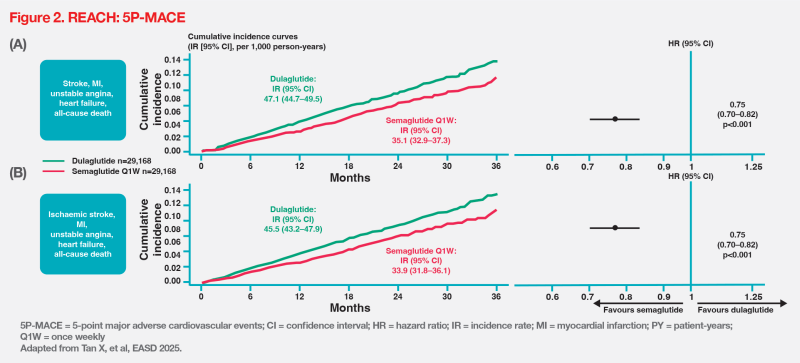
In patients with type 2 diabetes (T2D) and established atherosclerotic cardiovascular disease (ASCVD), subcutaneous (SC) semaglutide Q1W was associated with lower risks of 3-point and 5-point major adverse cardiovascular events (3P- and 5P-MACE) and all-cause mortality vs dulaglutide, according to the real-world REACH study presented at the European Association for the Study of Diabetes (EASD) 2025 Annual Meeting.
From ESC to EASD: Another CV win for semaglutide
The real-world STEER study, recently presented at the European Society of Cardiology (ESC) Congress 2025, demonstrated that SC semaglutide was associated with a lower risk of cardiovascular (CV) events vs tirzepatide in patients with overweight or obesity and ASCVD. [Wilson L, et al, ESC 2025]
The EASD 2025 Annual Meeting, held in mid-September 2025, featured another positive real-world CV outcome study – REACH – that compared effectiveness of semaglutide Q1W vs dulaglutide (both are glucagon-like peptide-1 receptor agonists [GLP- 1 RAs]) in patients with T2D and ASCVD. [Tan X, et al, EASD 2025]
REACH: Semaglutide vs dulaglutide in T2D and ASCVD
“Direct comparisons of CV outcomes within the class of GLP-1 RAs in real-world settings are lacking — a critical gap for the US Medicare population,” said Xi Tan from Novo Nordisk, Inc., Plainsboro, New Jersey, US, at EASD 2025. “This gap is even more concerning, given the growing population of US Medicare beneficiaries, who are older, often multimorbid, and underrepresented in clinical trials.”
By analyzing US Medicare free-for-service claims data from 1 January 2006 to 31 December 2022, patients with T2D and established ASCVD treated with semaglutide Q1W or dulaglutide were included in the REACH study.
“REACH was conducted under a target-trial emulation framework, which is a rigorous causal inference approach that used real-world data to simulate a hypothetical randomized controlled trial to estimate the treatment effect,” pointed out Tan.
Following propensity score matching, there were no significant differences in baseline characteristics between the semaglutide (n=29,168; mean age, 73.20 years; male, 60.5 percent; mean follow-up time, 12 months) and dulaglutide (n=29,168; mean age, 73.25 years; male, 60.9 percent; mean follow-up time, 13 months) groups. The mean durations of T2D and ASCVD history were approximately 6 and 7 years, respectively, in both groups.
23 percent risk reduction in 3P-MACE with semaglutide
The primary outcome was 3P-MACE, which included MI, stroke (ischaemic and haemorrhagic), and all-cause mortality.
Notably, semaglutide significantly reduced the risk of 3P-MACE by 23 percent (hazard ratio [HR], 0.77; 95 percent confidence interval [CI], 0.71–0.84; p<0.001) vs dulaglutide. (Figure 1A) “The cumulative incidence curves separated early,” reported Tan.

“When replacing overall stroke with ischaemic stroke, the results remained the same,” noted Tan. “Semaglutide consistently reduced the risk of 3P-MACE by 23 percent [HR, 0.77; 95 percent CI, 0.71– 0.85; p<0.001] vs dulaglutide.” (Figure 1B)
“Similar results were observed in a replicate analysis using US commercial and Medicare Advantage data,” Tan added.
As for the individual MACE components, semaglutide was associated with lower risks of:
- Stroke (HR, 0.67; 95 percent CI, 0.56–0.80; p<0.001);
- Ischaemic stroke (HR, 0.65; 95 percent CI, 0.53–0.80; p<0.001);
- All-cause mortality (HR, 0.74; 95 percent CI, 0.66–0.83; p<0.001).
However, no significant difference in the risk of MI (HR, 0.90; 95 percent CI, 0.76–1.06; p=0.21) was observed between the two groups.
25 percent risk reduction in 5P-MACE with semaglutide
5P-MACE was defined as MI, stroke, hospitalizations for unstable angina and heart failure, and all-cause mortality. Semaglutide significantly reduced the risk of 5P-MACE by 25 percent (HR, 0.75; 95 percent, 0.70–0.82; p<0.001) vs dulaglutide. (Figure 2A) When replacing overall stroke with ischaemic stroke, the results remained entirely unchanged. (Figure 2B)

Clinical implications
“This is the first real-world comparison of CV outcomes between semaglutide Q1W and dulaglutide in US Medicare beneficiaries with T2D and ASCVD, strengthening existing evidence in the context of lacking head-to-head trials,” said Tan.
In summary, semaglutide was associated with reduced risks of CV outcomes, including a 23 percent risk reduction in 3P-MACE, a 25 percent risk reduction in 5P-MACE, and a 26 percent risk reduction in all-cause death compared with another GLP-1 RA, dulaglutide.
“Our findings reinforce that the CV benefits of semaglutide are multifaceted, molecule-specific, and cannot be generalized to the entire GLP-1 RA class,” pointed out Tan.
The REACH study addresses a critical evidence gap that is crucial for informing treatment decisions for clinicians and policymakers, particularly amid increasing use of GLP-1 RAs and ongoing Medicare price negotiations.
Strengths and limitations
The strengths of the real-world REACH study include its large Medicare population, use of the target trial emulation framework, advanced methodology, various definitions of outcomes and sensitivity analyses. Limitations included observational study design, data availability, and other constraints.